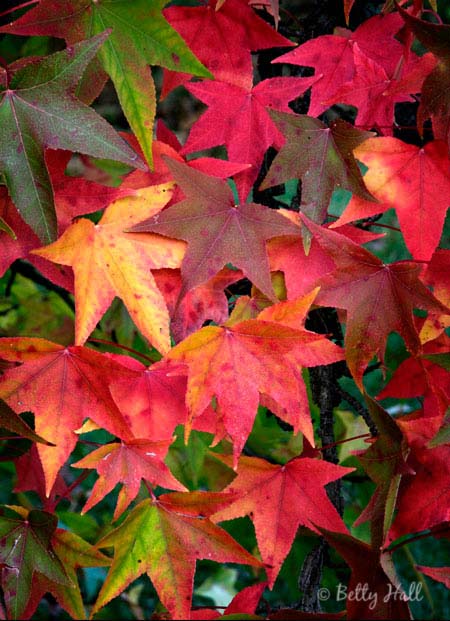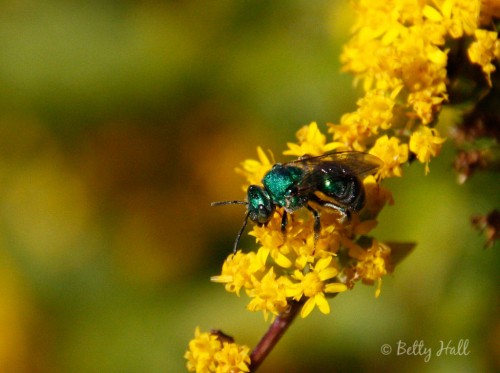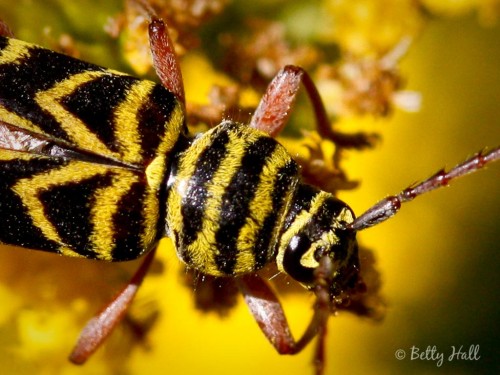The leaves of our Black Gum (Nyssa sylvatica) also known as Black Tupelo, and the Bald Cypress (Taxodium distichum) are signaling a change of seasons.
Category: Fall
Intriguing goldenrod visitors – Part 2
I’ve been using the photographs I took recently of the insect show on the Rough-leaved Goldenrod (Solidago rugosa) to try to identify the insects I saw.
I was surprised to discover that what I thought was an iridescent green fly was actually a sweat bee (Augochloropsis metallica).
And this interesting-looking insect is a Feather-legged Fly (Trichopoda pennipes). It doesn’t fit my mental image of a typical fly, and it’s considered a beneficial insect. I’ve not found any information on what function the leg “feathers” serve.
I wouldn’t have guessed this Yellow-collared Scape Moth (Cisseps fulvicollis) was a moth, either. It is apparently widespread over much of the U.S., feeds on flowers by day and is attracted to lights at night.
I’m not sure which is more challenging – getting good insect photographs or identifying the subjects later. I’ve got a lot to learn on both counts, and I look forward to discovering more about all of our backyard visitors – large and small.
What plants, birds, insects, etc., are you noticing in your backyard?
P.S. Click on the images to see a larger view.
Rough-leaved Goldenrod and Black Locust Borer
The Rough-leaved Goldenrod (Solidago rugosa) has been the most popular plant in the backyard recently. The airy, arching stems with yellow blossoms have been a gathering place for a myriad of insects including bees, flies, wasps, and unknowns, all busily feeding on nectar and gathering pollen.
This is one of the insects that got my attention (click images for larger versions).
I checked BugGuide and discovered it’s a Black Locust Borer (Megacyllene robiniae). Adults feed on pollen, particularly from goldenrods. The larvae live on Black Locust trees and can be a pest.
When I cropped an image to get this close-up, I was surprised to see that the body was somewhat fuzzy.
I enjoyed observing all the comings and goings on this goldenrod plant, and I’ve decided watching insects is great fun. There were far too many interesting creatures for one blog and I’ll share more images later.
Hearts-a-Burstin’ seedpods and seedlings
The seedpods on the Hearts-a-burstin’ (Euonymus americanus) shrub are one of many enjoyable backyard signs of autumn.
This plant seems quite happy growing under our pine tree where it’s dry and mostly shady. I enjoy it throughout the year and it is especially attractive this time of year.
I’m often amazed at the designs to be found in nature and these prickly magenta seedpods and brilliant red-orange seeds never cease to amaze me. This haiku, written by my friend, Beth Bailey, enriches and adds to what I see.
Joyous Transfusions
Drop by drop they dip
their nodding heads, their giving hearts
each bleeding beauty.
The seeds are food for birds and small mammals, but obviously not all of them get eaten. I have several small two-to-three inch seedlings.
I’ll be glad to share these with anyone who lives in the Lexington area. Please let me know if you are interested.
Thank You
There are many things for which I am grateful, including the beauty and wonders of the natural world – and the readers of this blog.
Photographing and writing for the blog have increased my enjoyment of the backyard and nature. And I have enjoyed sharing with others.
I especially appreciate those of you who have subscribed and everyone who has responded in writing or in person. The feedback has meant a lot.

One of my note cards features this photograph, taken at the Lexington Arboretum. As a token of my appreciation, I will gladly send this card to anyone who requests it by December 1, 2010.
Happy Thanksgiving!









